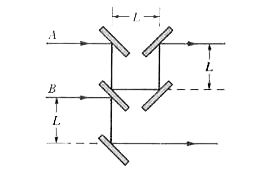The change in phase if a wave is reflected from a rigid surface is
zero
π radian
2π radian
π2 radian
The correct Answer is:B
Step by step video, text & image solution for The change in phase if a wave is reflected from a rigid surface is by Physics experts to help you in doubts & scoring excellent marks in Class 12 exams.
Updated on:21/07/2023Topper's Solved these Questions
- WAVESBook:AAKASH INSTITUTEChapter:WAVESExercise:Assignment (Section-B)
Explore 35 Videos
- WAVESBook:AAKASH INSTITUTEChapter:WAVESExercise:Assignment (Section-C)
Explore 11 Videos
- WAVESBook:AAKASH INSTITUTEChapter:WAVESExercise:Try Yourself
Explore 64 Videos
- WAVE OPTICSBook:AAKASH INSTITUTEChapter:WAVE OPTICSExercise:Assignment (Section-J (Aakash Challengers question))
Explore 1 Video
- WORK, ENERGY AND POWERBook:AAKASH INSTITUTEChapter:WORK, ENERGY AND POWERExercise:Assignment (SECTION - D)
Explore 15 Videos
Similar Questions
Knowledge Check
The change in phase, if a wave is reflected at a less dense surface, is
AzeroBπ radianCπ2 radianD2π3 radianA sinusoidal wave y1=asin(ωt−kx) is reflected from a rigid support and superpose with the incident wave y1 . Assume the rigid support to be at x=0.
AStationary waves are obtained with antinodes at the rigid support.BStationary waves are obtained with nodes at the rigid support.CStationary waves are obtained with intensity varying periodically with distance.DStationary waves are obtained with intensity varying periodically with time.What is phase difference,when longitudinal wave is reflected from rigid wall?
A0©Bπ©2CπcD2πc
Considering suitable examples, discuss the phase change when a wave is reflected from a free or open boundary.
View SolutionThe equation of a plane wave travelling along positive direction of x−axis is y=asin2πλ(vt−x) When the wave is reflected at a rigid surface and its amplitude becomes 80%, then find the equation of the reflected wave.
View SolutionIn Fig., sound waves A and B, both of wavelength λ , are initially in phase and traveling rightward, as indicated by the two rays. Wave A is reflected from four surfaces but ends up traveling in its original direction. Wave B ends in that direction after reflecting from two surfaces. Let distance L in the figure be expressed as a multiple q of λ:L=qλ. What are the (a) smallest and (b) third smallest values of q that put A and B exactly out of phase with each other after the reflections?

View SolutionA sound wave of frequency f propagasing through air with a velocity C, is reflected from a surface which is moving away from the source with a constant speed V. Find the frequency of the reflected wave, measured by the observer at the position of the source.
View SolutionWhich of the following parameters of a wave undergoes a· change when wave is reflected from a boundary?
View Solution

